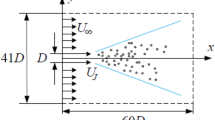Abstract
Large eddy simulations of nanoparticle coagulation in an incompressible planar jet were performed. The particle is described using a moment method to approximate the particle general dynamics equations. The time-averaged results based on 3000 time steps for every case were obtained to explore the influence of the Schmidt number and the Damkohler number on the nanoparticle dynamics. The results show that the changes of Schmidt number have the influence on the number concentration of nanoparticles only when the particle diameter is less than 1 nm for the fixed gas parameters. The number concentration of particles for small particles decreases more rapidly along the flow direction, and the nanoparticles with larger Schmidt number have a narrower distribution along the transverse direction. The smaller nanoparticles coagulate and disperse easily, grow rapidly hence show a stronger polydispersity. The smaller coagulation time scale can enhance the particle collision and coagulation. Frequented collision and coagulation bring a great increase in particle size. The large the Damkohler number is, the higher the particle polydispersity is.
Similar content being viewed by others
References
Yu M Z, Lin J Z, Chen L H. Large eddy simulation of a planar jet flow with nanoparticle coagulation[J]. Acta Mechanica Sinica, 2006, 22(4):293–300.
Miller S E, Garrick S C. Nanoparticle coagulation in a planar jet[J]. Aerosol Sci Technol, 2004, 38(1):79–89.
Garrick S C, Lehtinen K E J, Zachariah M R. Nanoparticle coagulation via a Navier-Stokes/nodal methodology: evolution of the particle field[J]. J Aerosol Sci, 2006, 37(5):555–576.
Lin J Z, Chan T L, Liu S, Zhou K, Zhou Y, Lee S C. Effects of coherent structures on nanoparticle coagulation and dispersion in a round jet[J]. Int J Nonlinear Sci Numer Simul, 2007, 8(1):45–54.
Smoluchowski V. Versuch einer mathematischen theorie der Koagulationskinetik kollider losungen[J]. Z Phys Chem, 1917, 92:129–168.
Frenklach M. Dynamics of discrete distribution for smoluchowski coagulation model[J]. J Colloid Interface Sci, 1985, 108(1):237–242.
Hulbert H M, Katz S. Some problems in particle technology: a statistical mechanical formulation[J]. Chem Eng Sci, 1964, 19(8):555–574.
Smith E J, Jordan L M. Mathematical and graphical interpretation of the lognormal law for particle size distribution analysis[J]. J Colloid Interface Sci, 1964, 19(6):549–559.
Frenklach M, Harris S J. Aerosol dynamics modeling using the method of moments[J]. J Colloid Interface Sci, 1987, 118(11):252–261.
Friedlander S K. Dynamics of aerosol formation by chemical reaction[J]. Ann NY Acad Sci, 1983, 404(1):354–364.
Pratsinis S E. Simultaneous nucleation, condensation, and coagulation in aerosol reactor[J]. J Colloid Interface Sci, 1988, 124(2):416–427.
McGraw R. Description of aerosol dynamics by the quadrature method of moments[J]. Aerosol Sci Technol, 1997, 27(2):255–265.
Settumba N, Garrick S C. Direct numerical simulation of nanoparticle coagulation in a temporal mixing layer via a moment method[J]. J Aerosol Sci, 2003, 34(1):149–167.
Talukdar S S, Swihart M T. Aerosol dynamics modeling of silicon nanoparticle formation during silane pyrolysis: a comparison of three solution methods[J]. J Aerosol Sci, 2004, 35(7):889–908.
Diemer R B, Olson J H. A moment methodology for coagulation and breakage problems: Part 1—analytical solution of the steady-state population balance[J]. Chem Eng Sci, 2002, 57(12):2193–2209.
Pratsinis S E, Kim K S. Particle coagulation, diffusion and thermophoresis in laminar tube flows[J]. J Aerosol Sci, 1989, 20(1):101–111.
Pyykonen J, Jokiniemi J. Computational fluid dynamics based sectional aerosol modeling schemes[J]. J Aerosol Sci, 2000, 31(5):531–550.
Terry D A, McGraw R, Rangel R H. Method of moments solution for a laminar flow aerosol reactor model[J]. Aerosol Sci Technol, 2001, 34(4):353–362.
Smagorinsky J. General circulation experiments with the primitive equation[J]. Mon Weather Rev, 1963, 91(3):99–164.
Lilly D K. A proposed modification of the Germano subgrid scale closure method[J]. Phys Fluids A, 1992, 4(3):633–635.
Friedlander S K. Smoke, dust and haze: fundamentals of aerosol behavior[M]. New York: Wiley Publication, 1977.
Suh S M, Zachariah M R, Girshick S L. Modeling particle formation during low-pressure silane oxidation: Detailed chemical kinetics and aerosol dynamics[J]. J Vac Sci Technol A, 2001, 19(3):940–951.
Author information
Authors and Affiliations
Corresponding author
Additional information
Contributed by LIN Jian-zhong
Project supported by the Major Basic Research Special Foundation of the Ministry of Science and Technology of China (No. 2005CCA06900)
Rights and permissions
About this article
Cite this article
Yu, Mz., Lin, Jz. & Chen, Lh. Nanoparticle coagulation in a planar jet via moment method. Appl. Math. Mech.-Engl. Ed. 28, 1445–1453 (2007). https://doi.org/10.1007/s10483-007-1104-8
Received:
Revised:
Issue Date:
DOI: https://doi.org/10.1007/s10483-007-1104-8




